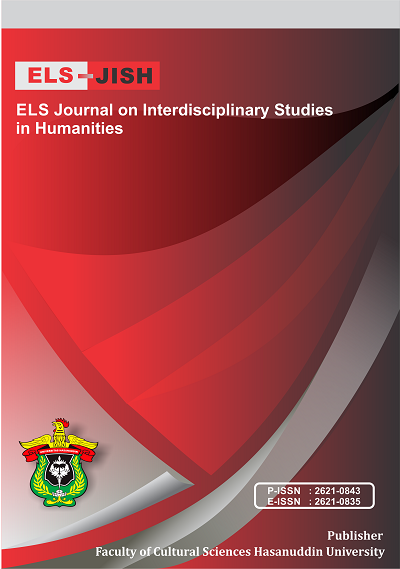Social Perception of Adolescents with Ambivert Personality When Doing Activities Alone in Public Spaces
DOI:
https://doi.org/10.34050/elsjish.v7i2.35173Keywords:
Adolescents, Ambivert Personality, Public Space, Social PerceptionAbstract
Public spaces are currently widely used by the community, especially after the end of the COVID-19 pandemic. Adolescents are actively utilizing facilities in public spaces. Adolescents are in a phase where they have a lot to say in social interactions. This phase is a chance for them to find their identity and will also affect their personalities. Carl Jung identified three types of personalities: extroverts, introverts, and ambiverts. Ambivert is a personality type that has good adaptability. The social environment or culture can influence personality. The social culture that has developed in Indonesia is collectivist. Collectivism requires the community to be bound by each other. The manifestations of collectivism are neighborhood associations, community associations, and community service. Social perception is a person's ability to understand other people with their sense of sight. The phenomenon that can be found in this research is the activity of adolescents with ambivert personalities alone in public spaces. The method used in this research is qualitative with a phenomenological approach. The data collection used unstructured and semi-structured interview techniques. This activity certainly arises from social perceptions of the surrounding environment. Perceptions arise because the habit is still rare in our society. Perceptions that arise include that a person has no friends, has an introverted personality, wants to spend time alone, isn't good at socializing, or some consider it a normal thing to do. As a result of these perceptions, adolescents with ambivert personalities feel uncomfortable doing activities alone in public spaces.
References
Arniati, F., Darwis, M., Rahman, N., & Rahman, F. (2019). Mother Behavior to Their Daughters As Seen in''Pride and Prejudice" and" Little Women". Parenting, 28, 25.
Byrne, R. A. B. & D. (2003). Psikologi Sosial Jilid 1 (L. P. L. Ratna Djuwita, Melania Meitty Parman, Dyah Yasmina (ed.); 10th ed.). Erlangga.
Claudia Mandy, J., Yudono, A., & Akil, A. (2019). Persepsi Pengunjung terhadap Kualitas Ruang Terbuka Publik di Kota Makassar (Studi Kasus: Lapangan Emmy Saelan). Jurnal Wilayah Dan Kota Maritim, 7(1), 92711.
Creswell, J. W. (2014). Research Design: Qualitative, Quantitative, and Mixed Methods Approaches / John W. Creswell (S. Publication (ed.); 4th ed.). Sage Publication.
Edwards, V. Van. (2024). What is an Ambivert? Take the Quiz to See if You’re an Introvert, Extrovert or Ambivert. Science of People. https://www.scienceofpeople.com/ambivert/
Geert Hofstede, G. J. H. (2004). Cultures and Organizations: Software for the Mind (M. H. Professional (ed.); 2nd ed.). McGraw Hill Professional. https://books.google.co.id/books/about/Cultures_and_Organizations_Software_for.html?hl=id&id=7mslqQWDP10C&redir_esc=y
Groth-Marnat, G., & Roberts, L. (1998). Human Figure Drawing and House Tree Person Drawing as Indicators of Self-Esteem: A Quantitative Approach. Journal of Clinical Psychology, 54(2), 219–222.
Hanifah, H., & Raharjo, S. T. (2018). Relasi orangtua, anak dan peer group (penemuan konsep diri pada remaja, kasus pada siswa sman tanjungsari sumedang). Focus: Jurnal Pekerjaan Sosial, 1(2), 124-134.
Hariyadi, N. Z. S. (2022). Nilai Budaya Kolektivisme dan Perilaku Asertif pada Suku Jawa. Journal of Social and Industrial Psychology, 11(2), 62–71.
Irwansyah, D. S. K. N. (2021). Citra Diri Individu dan Negosiasi Muka Warga dengan Budaya Kolektivisme di Negara Berbudaya Individualisme. Jurnal Ilmu Komunikasi, 10(June), 44–54. https://doi.org/10.14710/interaksi.10.1.44-54
Junaid, S., Mujizat, A., & Andini, C. (2023). The Quality of Human and Non-Human Relation in Indonesia and England Portrayed in the Selected Picture Books. ELS Journal on Interdisciplinary Studies in Humanities, 6(2), 211-218.
Jung, C. G. (1967). The Collected Work of C. G.Jung: Symbols of Transformation (Volume 5) (G. A. and R. F. C. Hull (ed.); 5th ed.). Bollingen Series.
Liem, S., Panggabean, H., & Farady, R. M. (2019). Persepsi Sosial Tentang Stunting di Kabupaten Tangerang. Jurnal Ekologi Kesehatan, 18(1), 37–47. https://doi.org/10.22435/jek.18.1.167.37-47
Mehta, V. (2019). Evaluating Public Space. Journal of Urban Design, 19(1), 53–88. https://doi.org/10.1080/13574809.2013.854698
Nickerson, C. (2024). What Is An Ambivert Personality? Simply. https://introvertdear.com/ambivert-meaning-definition/
Petric, D. (2022). The Introvert-Ambivert-Extrovert Spectrum. Open Journal of Medical Psychology, 11(03), 103–111. https://doi.org/10.4236/ojmp.2022.113008
Prihandoko, L. A., Anggawirya, A. M., & Rahman, F. (2021, December). Students’ Perceptions Towards Autonomous Learners Concept in Academic Writing Classes: Sequential Mixed-Method. In International Joined Conference on Social Science (ICSS 2021) (pp. 487-491). Atlantis Press.
Putro, K. Z. (2019). Memahami Ciri dan Tugas Perkembangan Masa Remaja. Aplikasia: Jurnal Aplikasi Ilmu-ilmu Agama, 17(1): 25-32.
Rachmawati, I. N. (2007). Pengumpulan Data dalam Penelitian Kualitatif: Wawancara. Jurnal Keprawatan Indonesia, 11(1), 35–40.
Rahman, F., & Weda, S. (2018). Students’ perceptions in appreciating English literary works through critical comment: A case study at Hasanuddin University and Universitas Negeri Makassar. Asian EFL Journal, 20(3), 149-172.
Saucedo, K. (2024). Ambivert Vs. Omnivert. SimplyPsychology. https://www.simplypsychology.org/ambivert-vs-omnivert.html
Sugiyono. (2008). Metode Penelitian Pendidikan: (Pendekatan Kuantitatif, Kualitatif, an R & D) (Alfabeta (ed.); 6th ed.). Alfabeta.
Sugiyono. (2018). Metode penelitian kuantitatif Prof. Dr. Sugiyono (Alfabeta (ed.); 1st ed.). Alfabeta.
Tantri, A. K. N. Y. E. (2020). Resistensi Ruang Publik di Tengah Covid-19 Perspektif Islam dan Komunikasi Multikultural. Komunike: Jurnal Komunikasi Penyiaran Islam, 12(1), 24–40.
Walgito, P. D. B. (2003). Pengantar Psikologi Umum (P. Dr. & B. Walgito (eds.); 4th ed.). Andi Offset.
Wasisto, K. M. J. (2020). Persepsi Mahasiswa Program Studi Ilmu Perpustakaan Universitas Diponegoro pada Peluang Kerja Information Professional. Jurnal Ilmu Perpustakaan, 9(2), 117–122. https://doi.org/10.1515/9783110769043-010
Downloads
Published
Issue
Section
License
Copyright (c) 2024 Bayu Anggoro, Vera Imanti

This work is licensed under a Creative Commons Attribution-ShareAlike 4.0 International License.






